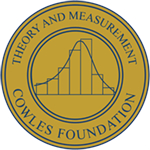Document Type
Discussion Paper
Publication Date
7-1-2006
CFDP Number
1572
CFDP Pages
21
Abstract
A game theoretic approach to the theory of money and financial institution is given utilizing both the strategic and coalitional forms for describing the economy. The economy is first modeled as a strategic market game, then the strategic form is used to calculate several cooperative forms that differ from each other in their utilization of money and credit and their treatment of threats. It is shown that there are natural upper and lower bounds to the monetary needs of an economy, but even in the extreme structures the concept of “enough money” can be defined usefully, and for large economies the games obtained from the lower and upper bounds have cores that approach the same limit that is an efficient price system. The role of disequilibrium is then discussed.
Recommended Citation
Shubik, Martin, "The Theory of Money and Financial Institutions: A Summary of a Game Theoretic Approach" (2006). Cowles Foundation Discussion Papers. 1863.
https://elischolar.library.yale.edu/cowles-discussion-paper-series/1863



